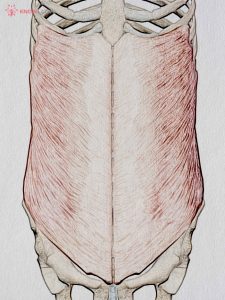The anterolateral abdominal wall consists of four main layers (external to internal): skin, superficial fascia, muscles and associated fascia, and parietal peritoneum.
The muscles of the anterolateral abdominal wall can be divided into two main groups:
Flat Muscles
There are three flat muscles located laterally in the abdominal wall, stacked upon one another. Their fibres run in differing directions and cross each other strengthening the wall and decreasing the risk of abdominal contents herniating through the wall. They are three flat muscles, situated laterally on either side of the abdomen:
- Abdominal External Oblique ;
- Abdominal Internal Oblique;
- Transverse abdominal .
In the anteromedial aspect of the abdominal wall, each flat muscle forms an aponeurosis (a broad, flat tendon), which covers the vertical Rectus Abdominis muscle. The aponeuroses of all the flat muscles, after surrounding the Rectus Abdominis, become entwined in the midline, forming the linea alba (a fibrous structure that extends from the xiphoid process of the sternum to the pubic symphysis).
Vertical Muscles
There are two vertical muscles located near the midline of the anterolateral abdominal wall:
- Rectus Abdominis;
- Pyramidalis.
Another muscle is part of this group: the Cremaster. It is continuous with the Abdominal Internal Oblique and its mainn function is to regulate the temperature of the testis, important for spermatogenesis. In females, this muscle does not grow or develop and can only be found as a round ligament in the uterus.

